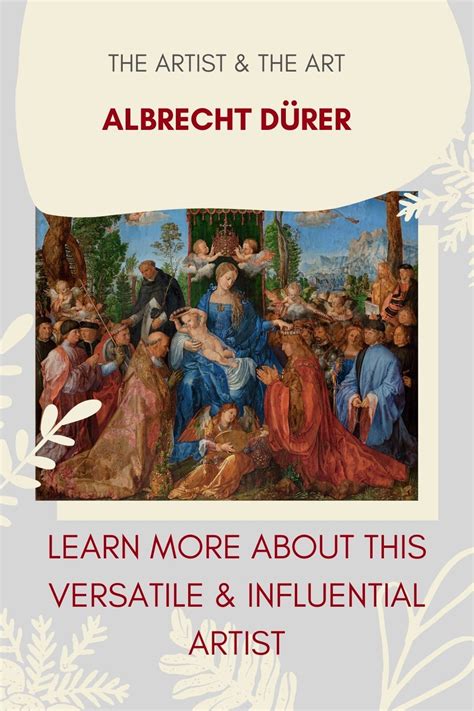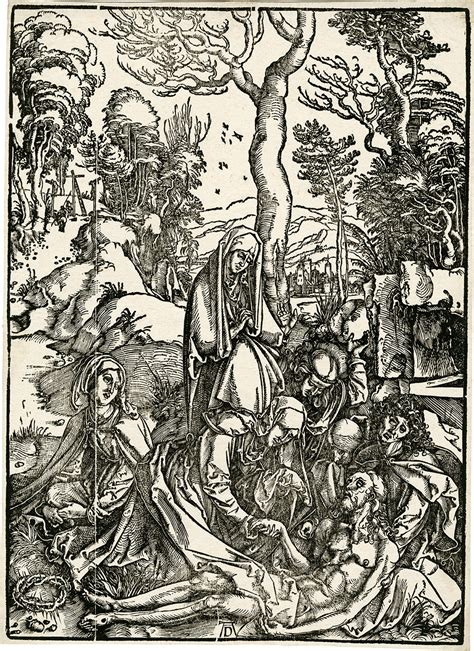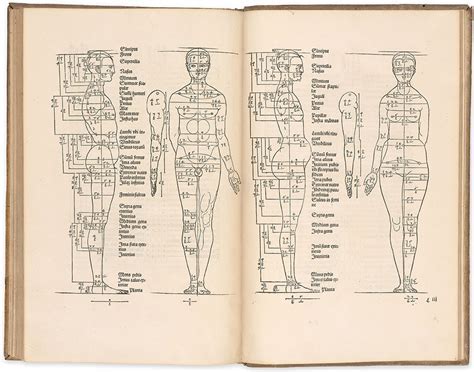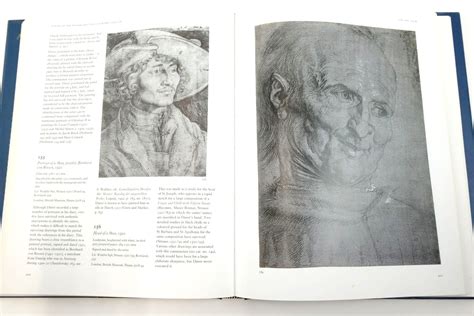In the realm of art history, there are few figures as enigmatic and influential as the prodigious Albrecht Durer. Born in 1471 in the heartland of Germany, Durer left behind a remarkable legacy that continues to captivate generations of art enthusiasts. His unrivaled mastery of various mediums, his dedication to technical precision, and his unwavering commitment to intellectual exploration established him as a pioneer of the Northern Renaissance.
Durer's artistic journey was not solely defined by his remarkable skill and craftsmanship; rather, it was his relentless pursuit of innovation that set him apart from his contemporaries. As a devoted observer of nature, Durer sought to faithfully depict the world around him, employing meticulous attention to detail and a deep understanding of human anatomy. Through his captivating engravings, woodcuts, and paintings, he breathed life into his subjects, infusing them with a sense of realism unparalleled in his era.
But Durer's influence extended far beyond his technical prowess and aesthetic achievements. He possessed a restless mind, constantly exploring new territories and pushing the boundaries of artistic expression. In an age marred by religious strife and social turbulence, Durer's art served as a powerful tool for communication, allowing him to convey complex ideas and emotions.
Today, Durer's works continue to command attention and admiration for their timelessness and universality. From his meticulously rendered self-portraits to his iconic depictions of biblical scenes, Durer's art transcends temporal and cultural boundaries, eliciting emotions and provoking thoughts in viewers of all backgrounds. His profound impact on the art world and his enduring legacy are testaments to his status as one of history's most remarkable artists.
Early Beginnings and Educational Journey: Tracing Albrecht Durer's Path to Mastering the Artistic Craft

In the realm of creativity and artistic expression, a profound individual emerged during the Renaissance period. This individual, born in 1471 in present-day Germany, would later captivate the art world with his exceptional talent and innovative techniques. Albrecht Durer embarked on a journey that would shape his future as one of the most exceptional artists of his time.
During his formative years, Durer displayed a natural inclination towards the arts, captivating those around him with his innate ability to perceive and depict the world around him. Recognizing his son's potential, Durer's father, a goldsmith by trade, supported his passion and ensured that he received a strong education to nurture his artistic aspirations.
Durer, the young prodigy, embarked on an educational journey that allowed him to develop his artistic skills. He immersed himself in the teachings of renowned painters and printmakers, studying the techniques employed by skilled craftsmen of the time. From an early age, Durer showed an immense dedication to his craft, constantly seeking opportunities to refine his abilities and expand his artistic horizons.
As his skills flourished, Durer began to explore various mediums, including woodcut prints and oil paintings. Through rigorous practice, he mastered the intricate art of engraving and etching, elevating his work to new levels of precision and detail. With each stroke of his brush or chisel, Durer's talent continued to evolve, earning him recognition and admiration from fellow artists and art enthusiasts alike.
From his humble beginnings, Albrecht Durer emerged as a prominent figure, leaving an enduring mark on the world of art. His early life and education laid the foundation for his artistic mastery, instilling in him a relentless pursuit of perfection and a thirst for innovation that would shape his extraordinary legacy.
Exploring Durer's Iconic Works: A Closer Look at His Famous Paintings
Delve into the artistic brilliance of one of Germany's most celebrated painters, Albrecht Durer. In this section, we will delve into the extraordinary paintings that have contributed to Durer's enduring reputation as a master artist. Through a detailed examination of his iconic works, we can gain a deeper appreciation for his unique style and artistic prowess.
Durer's Influence on Printmaking: Revolutionizing the Art of Woodcuts and Engravings

Durer revolutionized the art of printmaking through his innovative techniques and unparalleled mastery of woodcuts and engravings. His groundbreaking contributions to this medium not only transformed the artistic landscape of his time but also left an indelible mark on future generations.
By elevating the status of printmaking from a mere reproduction method to a medium of artistic expression, Durer expanded the possibilities of visual storytelling and dissemination of ideas. He skillfully exploited the unique characteristics of woodcuts and engravings, harnessing their potential to create intricate details, rich textures, and nuanced shading.
One of Durer's notable achievements was his development of a new approach to woodcutting, known as the chiaroscuro technique. By experimenting with various depths of carving and the application of ink, he achieved a remarkable level of tonal variation in his prints, imbuing them with a sense of three-dimensionality previously unseen in the medium.
Durer's technical virtuosity in engraving was equally groundbreaking. He pushed the boundaries of this meticulous art form, utilizing finely detailed lines and cross-hatching to create intricate compositions and achieve a remarkable level of realism. His engravings demonstrated his masterful understanding of perspective and anatomy, captivating viewers with their realism and emotional depth.
Furthermore, Durer's exploration of subjects and themes in his prints expanded the artistic vocabulary of printmaking. His prints encompassed a wide range of genres, from religious and mythological scenes to portraiture and landscapes. His keen observation of nature and his ability to capture the essence of his subjects in prints revealed his deep connection with the world around him.
The influence of Durer's innovations in printmaking can still be felt today. His technical mastery, attention to detail, and expressive power continue to inspire contemporary artists. From the Renaissance to the present day, Durer's prints have served as a benchmark for excellence in the field, setting a standard that artists aspire to achieve.
In conclusion, Durer's influence on printmaking cannot be overstated. Through his experimentation, technical mastery, and artistic vision, he revolutionized the art of woodcuts and engravings, elevating them to a level of artistic expression previously unimagined. His impact on the medium continues to resonate, making him one of the most influential printmakers in the history of art.
The Enigmatic Last Self-Portrait: Durer's Unfinished Masterpiece
Delve into the intriguing world of one of Germany's most celebrated artists, whose enigmatic last self-portrait continues to captivate art enthusiasts and scholars alike. As Albrecht Durer neared the end of his illustrious career, he embarked on a final artistic endeavor that remains shrouded in mystery. This unfinished masterpiece offers a mesmerizing glimpse into Durer's creative process and raises questions about the intentions behind this perplexing self-representation.
Beyond the Canvas: Durer's Fascination with Mathematics and Perspective

Explore the depths of Albrecht Durer's artistic genius as we delve into his passion for mathematics and perspective. Look beyond the surface of his renowned paintings and discover the intricate connections he made between art and science.
Throughout his career, Durer demonstrated a profound interest in mathematics and its application to art. He saw mathematics as a means to create precise and realistic representations of the world around him. By studying mathematical concepts such as geometry and proportion, Durer was able to meticulously craft his works to achieve a remarkable level of accuracy and detail.
One of the key areas where Durer's mathematical prowess shines through is his understanding and use of perspective. He recognized the power of perspective in creating the illusion of depth and space on a two-dimensional canvas. Durer's mastery of linear perspective allowed him to create realistic and immersive environments that captivate viewers even to this day.
In addition to perspective, Durer also explored the concept of proportions, particularly in relation to human anatomy. His fascination with the human form led him to study the mathematical principles governing the ideal proportions of the human body. This knowledge enabled him to accurately depict the human figure in his portraits and figure studies, creating a sense of harmony and balance that resonates with viewers.
| Mathematics and Art: | Durer's integration of mathematical concepts into his artistic practice fueled the development of his unique style and approach to representation. |
|---|---|
| The Impact of Perspective: | Durer's meticulous use of perspective techniques elevated his artworks, allowing viewers to immerse themselves in the depicted spaces. |
| The Harmonious Human Form: | Through his understanding of proportions, Durer portrayed the human body with remarkable accuracy and created a sense of aesthetic equilibrium in his works. |
In conclusion, Albrecht Durer's fascination with mathematics and perspective went far beyond his role as a renowned German artist. His deep understanding and application of mathematical principles revolutionized his art, creating a legacy that continues to inspire and amaze artists and art lovers alike.
Durer's Controversial Relationship with Religion: The Influence on His Artistic Expression
Durer's complex and thought-provoking connection with religion significantly shaped his artistic expression, leaving an indelible impact on the art world. His profound exploration of religious themes and his innovative approach to portraying them made a lasting impression on both his contemporaries and future generations.
The Representation of the Human Body in Durer's Art: A Comprehensive Analysis of Anatomy and Proportions

Examining the artistic oeuvre of the illustrious German artist Albrecht Durer, one cannot help but be captivated by his masterful depiction of the human figure. Throughout his career, Durer explored the intricacies of anatomy and proportions, showcasing a deep understanding of the human form and its harmonious composition within his works. In this section, we embark on a journey to delve into the captivating world of Durer's art, examining his meticulous attention to detail and the profound impact it had on the Renaissance art movement.
One of the hallmarks of Durer's artistic prowess lies in his ability to meticulously study and depict human anatomy. Through his extensive knowledge of the human body, he presented figures with flawless anatomical accuracy, infusing them with a sense of realism rarely seen before his time. In his drawings and paintings, Durer's figures possess a lifelike quality, emanating an unparalleled vitality and organic authenticity that continues to awe and inspire viewers even centuries later.
Furthermore, Durer's keen eye for proportions played a pivotal role in his artistic achievements. Taking cues from the classical ideal of beauty, Durer meticulously measured and calculated every aspect of his figures, ensuring that they adhered to precise mathematical ratios. This careful attention to proportions imbues his works with a sense of harmony and balance, evoking a sense of visual satisfaction in the viewer's eye.
Central to Durer's exploration of anatomy and proportions was his groundbreaking study of the human body through dissection. As one of the first artists to engage in such practices, Durer's commitment to understanding the inner workings of the human form enabled him to portray subjects with an unprecedented level of accuracy. By dissecting cadavers and scrutinizing their intricate structures, he gained invaluable insights into the complexity of human anatomy, which he skillfully translated into his art.
Truly a visionary in his approach to the human figure, Durer's meticulous study of anatomy and proportions revolutionized the way artists approached their craft. His profound understanding of the human form and his dedication to capturing its essence in his works resonate with audiences even to this day, cementing his enduring legacy as one of the most revered artists of the Renaissance period.
Durer's Career and Travels: Capturing the Essence of the Renaissance Era
In this section, we explore the intriguing journey of Albrecht Durer, a highly esteemed artist from Germany whose work came to define the essence of the Renaissance era. Durer's career was marked by a vibrant passion for art and a relentless desire to push the boundaries of artistic expression.
Ambitious and inquisitive, Durer embarked on numerous travels across Europe, immersing himself in different cultures, learning from the masters of his time, and exchanging ideas with fellow artists. These sojourns provided him with distinctive experiences and opportunities to observe the multifaceted facets of the Renaissance movement, which had swept the continent.
During his travels, Durer studied under various renowned artists, assimilating their techniques and refining his own unique style. His encounters with influential figures such as Giovanni Bellini and Andrea Mantegna in Italy influenced his artistic vision and propelled his journey towards greatness.
Durer's exploration of Renaissance themes resulted in an astonishing body of work that encapsulated the spirit of the era. His innovative use of perspective, meticulous attention to detail, and masterful manipulation of light and shadow brought his subjects to life in a way previously unseen.
Through his artwork, he seamlessly fused the classical influences of ancient Greece and Rome with the Christian motifs prevalent at the time, creating a harmonious blend that resonated with audiences across borders. Durer's skillful portrayal of religious subjects and his ability to capture the human form with remarkable accuracy exemplified the ideals of the Renaissance era.
His travels and exposure to diverse cultures enabled Durer to incorporate various artistic techniques and themes into his works, transcending the boundaries of traditional German art. His range of subjects expanded to include landscapes, portraits, and intricate engravings, showcasing his versatility and mastery of different mediums.
In conclusion, Durer's career and travels epitomize the spirit of the Renaissance era, as he tirelessly pursued artistic growth and drew inspiration from the vibrant cultural milieu of Europe. His legacy continues to inspire contemporary artists and art enthusiasts, reinforcing his status as an iconic figure in the history of art.
Durer's Legacy: Exploring His Enduring Influence on the World of Art and Culture

The impact of Albrecht Durer, a celebrated German artist and cultural figure from 1471 to 1528, on the realm of art and culture continues to be felt today. Through his innovative techniques, profound themes, and prolific body of work, Durer left an indelible mark on the artistic landscape of his time and beyond. His contributions not only transformed the way art was created and perceived, but also influenced future generations of artists, shaping the course of art history.
Durer's artistic legacy can be best understood through his mastery of various artistic mediums, including painting, printmaking, drawing, and watercolor. His skillful use of these mediums allowed him to bring his creative vision to life and convey intricate details and emotions in a way that resonated with viewers. Durer's works exhibited a meticulous attention to detail, coupled with a deep understanding of composition and perspective, which revolutionized the art world and established new standards for artistic excellence.
Beyond his technical proficiency, Durer's artistic themes and subject matter were groundbreaking for his time. His exploration of religious, mythological, and naturalistic motifs added depth and complexity to his works, captivating audiences and provoking intellectual discourse. Durer's ability to infuse symbolic meaning into his art elevated the medium beyond mere visual representation, making it a powerful tool for storytelling and conveying moral and philosophical concepts.
Durer's enduring impact on the world of art and culture can also be seen in his role as a pioneer of self-promotion and branding as an artist. Through the use of his distinctive monogram, which incorporated his initials 'AD' in a unique and recognizable design, Durer established a personal brand that became synonymous with quality and craftsmanship. This innovative approach to self-presentation helped solidify his reputation as a master artist and allowed his influence to extend far beyond the confines of his studio.
In conclusion, Albrecht Durer's artistic legacy continues to reverberate in the world of art and culture. His technical prowess, thematic exploration, and branding innovations have left an enduring impact on artists, scholars, and enthusiasts alike. Durer's profound contributions have shaped the course of art history and his influence can be felt in the works of countless artists across the centuries, making him a true icon of the Renaissance era and a testament to the power of artistic expression.
FAQ
Who was Albrecht Durer and why is he considered a renowned artist?
Albrecht Durer was a German artist who lived from 1471 to 1528. He is considered a renowned artist because of his immense talent and contributions to various art forms, including painting, printmaking, and engraving. His technical skill, attention to detail, and innovative techniques set him apart from other artists of his time.
What were some of Albrecht Durer's most famous works?
Albrecht Durer created numerous well-known works of art. Some of his most famous pieces include "Melancholia I," "The Knight, Death and the Devil," "The Four Horsemen of the Apocalypse," and "The Young Hare." These artworks showcase his mastery of composition, realistic depiction, and exploration of complex themes.
How did Albrecht Durer influence the art world during his time?
Albrecht Durer had a significant impact on the art world during the Renaissance period. He was one of the first artists to establish his reputation through prints and engravings, which enabled his artwork to reach a wider audience and inspired other artists. His intricate woodcuts and etchings set new standards for technical skill, and his emphasis on proportion and perspective influenced many subsequent artists.
What is the legacy of Albrecht Durer?
The legacy of Albrecht Durer is enduring and far-reaching. His technical innovations, such as his use of mathematical principles in his artwork, continue to inspire artists to this day. He is also remembered for his exploration of human anatomy, which laid the foundation for the scientific understanding of the human body. Durer's artistic achievements firmly established him as one of the greatest artists of the Renaissance and his works continue to be admired and studied by art lovers and scholars worldwide.



